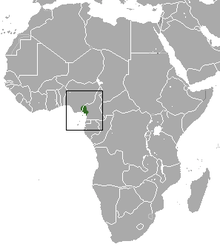Red-eared guenon
| Red-eared guenon[1] | |
|---|---|
| | |
| Scientific classification | |
| Kingdom: | Animalia |
| Phylum: | Chordata |
| Class: | Mammalia |
| Order: | Primates |
| Suborder: | Haplorhini |
| Infraorder: | Simiiformes |
| Family: | Cercopithecidae |
| Genus: | Cercopithecus |
| Species: | C. erythrotis |
| Binomial name | |
| Cercopithecus erythrotis Waterhouse, 1838[3] | |
 | |
| Red-eared Guenon range | |
The red-eared guenon, red-eared monkey, or russet-eared guenon (Cercopithecus erythrotis) is a species of primate in the family Cercopithecidae. It is found in Cameroon, Equatorial Guinea, and Nigeria. Its natural habitat is subtropical or tropical moist lowland forests. It is threatened by habitat loss,[2] illegal bushmeat hunting and pet trade.
Description
The red-eared guenon is a small, colourful monkey with distinctive facial markings which involve blue fur around its eyes, a brick-red nose and ears, and yellow cheeks. The silky fur on the body consists of banded brown and pale hairs with grey limbs and a long, red tail. The long tails are partially prehensile and are used by infants to cling to the female. The red eared guenon is an unobtrusive species which produces a quiet trill, unlike the loud long distance calls made by other guenons.[4] Males average 420mm head and bodylength, with a 609mm long tail, females are smaller with a mean head and body length of 384mm and an average tail length of 553mm.[5]
Distribution and subspecies
There are two recognised subspecies, which are listed below with their distributions:[3][5]
- Cercopithecus erythrotis camerunensis Hayman, 1940 Cameroon Red-eared Monkey: from the Cross River insouth eastern Nigeria and to just north of the Sanaga River in south western Cameroon.
- Cercopithecus erythrotis erythrotis Waterhouse, 1838 Bioko Red-eared Monkey:Bioko island in Equatorial Guinea.
Habitat
The red-eared guenon is found in primary and secondary lowland tropical and sub-montane moist forest, and sometimes lives in close proximity to humans, as on Bioko.[2]
Habits
The red-eared guenon is omnivorous and has been recorded eating fruit, leaves, shoots and insects, the latter are important for nutrition, especially for pregnant and lactating females. The red-eared guenon normally forms groups consisting of at least one adult male and around ten females with young which are not as hierarchical as some primate societies. They are territorial but they usually avoid conflict with other groups. The breeding biology of red-eared guenons is little known but similar species give birth to a single infant every one to three years, with pregnancy taking five or six months.
Threats
The red-eared guenon is threatened by deforestation and by the bushmeat trade, particularly on Bioko, where it is frequently recorded in bushmeat market in Malabo.[2]
References
- ↑ Groves, C.P. (2005). Wilson, D.E.; Reeder, D.M., eds. Mammal Species of the World: A Taxonomic and Geographic Reference (3rd ed.). Baltimore: Johns Hopkins University Press. p. 156. ISBN 0-801-88221-4. OCLC 62265494.
- 1 2 3 4 Oates, J. F.; Gippoliti, S. & Groves, C. P. (2008). "Cercopithecus erythrotis". IUCN Red List of Threatened Species. Version 2008. International Union for Conservation of Nature. Retrieved 4 January 2009.
- 1 2 "Cercopithecus erythrotis Waterhouse, 1838". Integrated Taxonomic Information System (ITIS) (http://www.itis.gov). Retrieved 23 November 2016.
- ↑ "Red-eared Guenon (Cercopithecus erythrotis)". Wildscreen Arkive. Wildscreen. Retrieved 23 November 2016.
- 1 2 Jonathan Kingdon; David Happold; Thomas Butynski; Michael Hoffmann; Meredith Happold; Jan Kalina (2013). Mammals of Africa Volumes 1-6. A&C Black. pp. 373–375. ISBN 1408189968.
